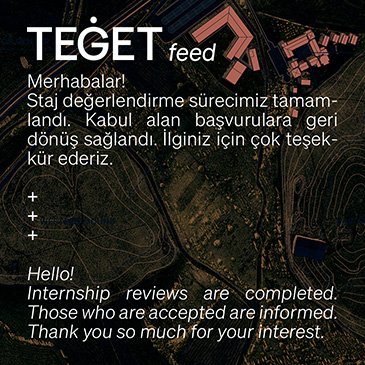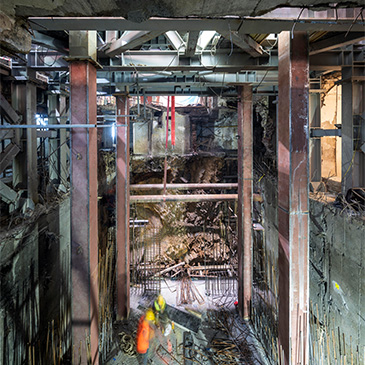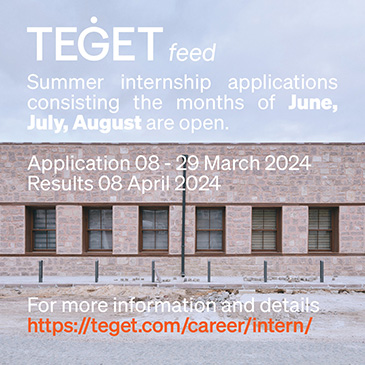AR New into Old Winner: Teget’s transformation of a bland bank building into the Yapı Kredi Culture Centre is an experimental cultural provocation
On the European side of Istanbul, in what is roughly the geographic centre of the vast metropolis, is the neighbourhood of Beyoğlu. Like much of Istanbul, Beyoğlu’s histories are manifest in the medieval towers, Neoclassical embassies and Modernist synagogues that run from the banks of the Golden Horn waterway up to the hilltop spine of İstiklal Avenue. Stretching virtually straight for two kilometres across the top of the hill, İstiklal is remarkable in a city of jumbled alleyways. With its 19th-century streetscape, it’s a boulevard that wouldn’t look out of place in Vienna or Paris. Indeed, the influence of French architects and engineers is hard to miss on the street once known as the Grande Rue de Péra. Between Gezi Park, designed by Henri Prost for Atatürk in 1943 at one end, and the Tünel, a 19th-century funicular railway designed by Eugène-Henri Gavand at the other, the İstiklal Avenue is lined with skinny, four-storey buildings with single facades.
Photographs of İstiklal from the 19th century show it busy with foot traffic and trams, and stores bearing the names of Greeks, Jews, Armenians and, of course, Turks. Halfway along the street it refracts around Galatasaray Square. On one side of the square is a French high school with dramatic iron gates, through which an illustrious array of alumni have passed, including former Turkish Presidents and Yitzhak Ben-Zvi, second President of Israel. On the other side, with one facade facing onto İstiklal, the other onto the square, is the Yapı Kredi Kültür Sanat (YKKS, Yapı Kredi Culture Centre), which reopened its doors to the public last month after a seven-year refurbishment period overseen by architects Teget.
In what might be described as İstiklal’s – indeed the neighbourhood’s – heyday in the early- to mid-20th century, the plot was occupied by Neoclassical apartments and commercial units typical of the streetscape. In the 1950s, however, this pattern was interrupted. The apartments were demolished and replaced with a Rationalist office building for the headquarters of Yapı Kredi, the fourth largest public bank in Turkey and a major patron of visual arts and literature. For over half a century its headquarters housed both its commercial offices and cultural facilities: gallery spaces, a library and the offices of Yapı Kredi Publications, one of the largest publishers in the country, printing contemporary fiction, Turkish classics and translations including the first Turkish print of Harry Potter.

Designed by the German architect Paul Schmitthenner, the building was structured with a rectilinear concrete frame and featured a gridded travertine facade and open portico at street level. Minor adjustments since its construction – an extra floor following new building codes here, the closure of the portico for a bank branch there – did little to change the fact that this was a fairly unremarkable building both for its time and context by an architect with Nazi associations and ‘almost fascist’ design principles, as described by Mehmet Kütükçüoğlu, principal and co-founder of Teget.
Acknowledging the relative blandness of Schmitthenner’s original building is fundamental to understanding the recent renovation and conversion work by Teget on the YKKS building. This is renovation of cultural architecture in the vein of OMA’s Garage Museum of Contemporary Art in Moscow, as opposed to John Pawson’s Design Museum in London. The original features of Schmitthenner’s building that remain today are not preserved out of any particular architectural respect, cultural nostalgia or in accordance with heritage requirements. Instead Teget opted for renovation over demolition as both an experiment in architectural practice and a cultural provocation. As Kütükçüoğlu explains, the lack of heritage protection for the building presented a rare opportunity to work with historic materials in an entirely new way: ‘This created a chance to show architects that you could preserve, and at the same time drastically transform something’.
Yet perhaps more compelling for Kütükçüoğlu and the Teget team was an opportunity to challenge a prevailing building culture in Istanbul that currently favours populist statements of shiny novelty or repolished imperialism (the nearby Demirören shopping mall is in fact an amalgamation of both – a Hadid-esque interior behind an entirely reconstructed Neoclassical facade). Against recommendations to demolish Schmitthenner’s building by both the city mayor and heritage council, Teget decided to work with the Rationalist structure. As Kütükçüoğlu explains, ‘We used this as a provocation to the common practice in the city, where things are being built from scratch over and over again. The new administration is not tolerant to what is old, unless it’s a hundred years old or more, so you almost lose your childhood every time the city changes skin every twenty, thirty years.’

The resulting palimpsest combines Rationalist Modernism and civic spirit with high culture and photogenic flourishes. The street-facing facade of Schmitthenner’s building has been retained in its entirety with its street-level portico re-opened to the public. Avoiding the client’s proposal for another bank branch, a large, busy bookshop selling exclusively Yapı Kredi publications greets visitors approaching from the south. Approaching from the north, however, is the showstopper. A six-storey curtain wall made from ‘ultra-transparent’ glass is visible from along İstiklal Avenue and opens the building onto Galatasaray Square, where before it was closed and uncommunicative. The screen reveals an atrium with travertine half-turn staircases that lead visitors up from the portico to the galleries and loca (Turkish for lodge, a double-height function room intended for talks, concerts, screenings etc). Halfway up the atrium sits Akdeniz by Ilhan Koman, one of Turkey’s most famous sculptures, whose open arms draw in visitors from Galatasaray Square and provide optimum selfie-fodder. Akdeniz and the open facade effectively extend YKKS into the surrounding public space. This fluid connection between interior and exterior is emphasised throughout the project. Visual connections to the street and wider city punctuate the bookshop, galleries and loca as well as the offices and library on the upper floors, accessible from a separate entrance beneath the İstiklal-facing facade.
Where the previous structure assembled cultural and banking facilities in a jumble across different floors and volumes, Teget’s reconstruction is highly legible, separating the building’s functions into three clear volumes progressing back from Galatasaray Square: atrium; a central, publicly accessible core; and service and administration departments on the upper floors. There is a clear separation between the public-facing elements – the bookshop and galleries – and the administrative and service departments, facilitating a spatial clarity that is impressive, considering the relatively compact nature of the plot and the density of functions it contains. This clarity is reinforced by a newly commissioned graphic interface consistent across both public- and private-facing sections. Newly designed furniture also populates the building from the publishers’ editorial offices to the children’s section of the bookshop – black steel bookshelves, softly lit to expose the covers of the Yapı Kredi collection are particularly impressive.

The architects and YKKS team hope the reopened complex will have an impact beyond its travertine walls; that it might ignite a revival for the Beyoğlu neighbourhood which has suffered a decline over the last decade or so. ‘A rose in the mud’ is how building manager Targan describes his new office. Once a hub for nightlife, cinemas, bookshops and bars, the crackdown on civic life after the nearby Gezi Park protests has diluted İstiklal. Restaurants have been forced to bring their street-side tables inside and it is now mainly populated by tourists and stores to suit them – Nikes and Zaras between tourist knick-knacks. Kütükçüoğlu hopes the reopened YKKS building could turn this around: ‘When we built this thing here, that stirred something up in people. There’s something nice introduced here. We hope after this one the others will come and then maybe we will start another wave for this street.’
Indeed, a modest yet steady flow of curious visitors populates YKKS a month after its reopening; young Turks stop for photo opportunities in the atrium and an older group take in a documentary on the Queen’s visit to Istanbul in 1971 in the loca. One gallery visitor explains that he had stopped coming to the area because of the protests and heavy building work, but had heard about the new YKKS and so stopped by with friends.
Currently the building itself seems to be attracting more attention than the centre’s cultural programme. As the centre’s events coordinator Ahsen Erdoğan points out, ‘It is not enough only to open an art gallery or museum any more. The architecture of a place should be enticing. People will come to see the place because they are interested not only in the exhibitions but also in its architecture’. Certainly a mark of due respect for Teget, but perhaps a little worrying for their hopes to reinvigorate the neighbourhood in the long term. The opening exhibition is a somewhat disjointed tour through the Yapı Kredi collection of visual art – a stronger offering will certainly be required to keep these intrigued crowds coming back.
Nonetheless, for now the building is a hit. Its generous portico, promenade architecturale and open facade complement the civic centre of gravity of the square and its surrounds. Perhaps more importantly, Teget’s Rationalist renovation and reinterpretation at YKKS are productive, even radical acts in a political and cultural context that is overly nostalgic and increasingly devoid of reason.




